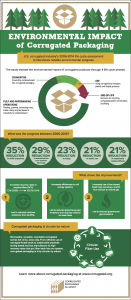We know it mainly as the brown shipping box, although it also comes in various other shapes, sizes and colours. Whatever, the humble corrugated box just got better.

According to a life cycle analysis released last week, the average US corrugated box has made significant strides since a previous LCA conducted back in 2006:
- 35% reduction in greenhouse gas emissions
- 29% reduction in eutrophication from nutrient discharge
- 23% reduction in smog
- 21% reduction in water use and a
- 21% reduction in respiratory related effects.
The latest LCA (2014) was conducted by the National Council for Air and Stream Improvement (NCASI) for the Corrugated Packaging Alliance, and meets the ISO 14040/14044 standards for a publicly disclosed study. It also has a Canadian connection: the external reviewer was Lindita Bushi of the Athena Institute.
The main reasons for the significant reduction in greenhouse gas emissions were increased recovery rates for old corrugated containers (OCC); greater efficiencies in mill energy systems; and increased use of low-impact fossil fuels, including a switch from oil/coal to natural gas.
An executive summary of the LCA can be found here. For the full LCA (199 pages) click here.
